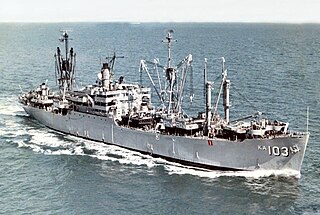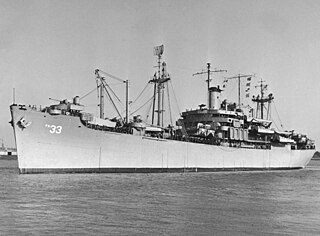
The Amphibious Vehicle, Tracked (LVT) is an amphibious warfare vehicle and amphibious landing craft, introduced by the United States Navy and United States Marine Corps. The United States Army, Canadian Army and British Army used several LVT models during World War II, and referred to those vehicles as "Landing Vehicle, Tracked."

Amphibious cargo ships were U.S. Navy ships designed specifically to carry troops, heavy equipment and supplies in support of amphibious assaults, and to provide naval gunfire support during those assaults. A total of 108 of these ships were built between 1943 and 1945—which worked out to an average of one ship every eight days. Six additional AKAs, featuring new and improved designs, were built in later years. They were originally called Attack Cargo Ships and designated AKA. In 1969, they were renamed as Amphibious Cargo Ships and redesignated LKA.

Attack transport is a United States Navy ship classification for a variant of ocean-going troopship adapted to transporting invasion forces ashore. Unlike standard troopships – often drafted from the merchant fleet – that rely on either a quay or tenders, attack transports carry their own fleet of landing craft, such as the landing craft, vehicle, personnel (LCVP) or Higgins boat.

Haskell-class attack transports (APA) were amphibious assault ships of the United States Navy created in 1944. They were designed to transport 1,500 troops and their combat equipment, and land them on hostile shores with the ships' integral landing craft.

The Tolland-class attack cargo ships were built by North Carolina Shipbuilding Co. in Wilmington, North Carolina during the latter stages of World War II.

The Andromeda-class attack cargo ships were a class of amphibious cargo ship built by Federal Shipbuilding & Drydock Co. in Kearny, New Jersey, and Moore Dry Dock Co., in Oakland, California, during World War II. Like all attack cargo ships, they were designed to carry combat loaded military cargo and landing craft, and to use the latter to land weapons, supplies, and troops on enemy shores during amphibious operations.

The Arcturus-class attack cargo ships were converted from other ship types by Sun Shipbuilding & Drydock Co. in Chester, Pennsylvania, Tampa Shipbuilding Co. in Tampa, Florida, and Federal Shipbuilding & Drydock Co. in Kearny, New Jersey, during World War II.

The 3-inch/50-caliber gun in United States naval gun terminology indicates the gun fired a projectile 3 inches (76 mm) in diameter, and the barrel was 50 calibers long. Different guns of this caliber were used by the U.S. Navy and U.S. Coast Guard from 1900 through to 1990 on a variety of combatant and transport ship classes.

The Type 074 landing ship is a class of landing ship medium (LSM) of the People's Liberation Army Navy. They were built at Wuhu Shipyard of Wuhu, Anhui from 1995 to 2000. Although entering service in the mid-1990s, the origin of Type 074 dates to almost three decades earlier in the mid-1960s, and Type 074 is the result of experience learned from around half a dozen models earlier.

The Gilliam-class attack transport was a class of attack transport built for service with the US Navy in World War II.

The Bayfield-class attack transport was a class of US Navy attack transports that were built during World War II.

The Ormsby-class attack transport was a class of US Navy attack transport that saw service in World War II.

The Crescent City-class attack transport was a class of U.S. Navy attack transports that saw service in World War II and the Korean War. There were four ships in the class: USS Crescent City, USS Charles Carroll, USS Monrovia, and USS Calvert.

The Harris-class attack transport was a class of US Navy attack transport which saw service in World War II. The purpose of any attack transport was to deliver troops and their equipment to hostile shores in order to execute amphibious invasions using an array of smaller integral landing craft. Being intended to serve in forward combat areas, these ships were well armed with antiaircraft guns to protect itself and its vulnerable cargo of troops from air attack in the battle zone.

The McCawley-class attack transport was a class of US Navy attack transport built in 1928 that saw service in World War II.

The President Jackson-class attack transport was a class of seven US Navy attack transport that saw service in World War II.

The Arthur Middleton-class attack transport was a class of three US Navy attack transport that saw most of its service in World War II. Ships of the class were named after signatories of the American Declaration of Independence.

The Doyen-class attack transport was a class of two attack transports that saw service with the US Navy in World War II. Ships of the class were named after generals of the United States Marine Corps.

An amphibious warfare ship is an amphibious vehicle warship employed to land and support ground forces, such as marines, on enemy territory during an amphibious assault.

The Ashland-class dock landing ship were the first class of dock landing ship of the United States Navy. They were built during World War II. A dock landing ship is a form of auxiliary warship designed to support amphibious operations. Eight ships were built for the United States Navy and they remained in US service until the 1960s. Two of the class were sold for export overseas, with one joining the Republic of China Navy and the other the Argentinian Navy. The two transferred ships stayed in service until the 1980s. All eight ships were scrapped.




















